Turo is a US based peer to peer marketplace for car rentals.
The platform began its journey in Baltimore in 2010 under the name RelayRides. Since then, the solution has gone through thousands of iterations that have turned it into the largest peer to peer car rental marketplace in the world.
What is Turo? A car rental website
In simple terms, Turo is the Airbnb of car rentals.
The technical way to say this is that Turo is a location based, peer to peer rental marketplace for cars:
- Location based means that the consumer must be in the same location as the listing in order to complete the transaction.
- Peer to peer (p2p) describes how Turo’s main users interact. On a p2p marketplace, the main users are private individuals. In Turo’s case, the private individuals are car owners and car renters.
- Car rental marketplace describes the type of asset that is offered on the marketplace.
Even more specifically, Turo targets travellers looking to rent a car for 1 day or longer.
Now that we know what Turo is, let’s take a look at how car rental websites like Turo work.
How car rental websites like Turo work
Car owners can login to Turo’s car rental website and upload basic information about their cars such as the price they want to rent the car out for. Individuals who want to rent out these cars can log into Turo, browse lists of uploaded cars in their local area, select a time to rent these cars for and rent the cars out.
Below is an image of a car listing on Turo’s website that you can click to rent.
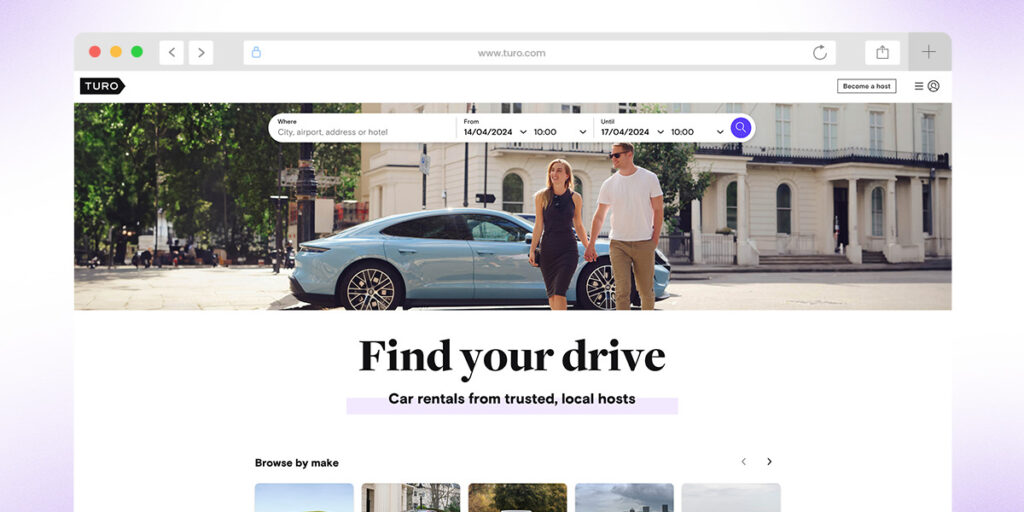
Turo is different from solutions like ZipCar. This is because Turo does not own any of the car rentals on its website. Instead Turo relies on a peer to peer marketplace model where individual car owners upload their own cars to Turo and Turo provides a platform for these cars to be rented out.
How did Turo start their marketplace for car rentals?
Turo started out in 2010 as RelayRides. The platform was then founded by Shelby Clark.
At the time, Shelby was living in Boston and was looking to buy a car. While he looked for a car to drive, he signed up to the popular car sharing app ZipCar that allows individuals to rent cars from the ZipCar fleet. The problem with ZipCar was that if he needed a car, he would need to rent it weeks in advance otherwise all the cars nearby would be taken.
The story goes that, one day in the winter, he was cycling along in the Boston cold looking for his ZipCar ride. As he cycled down blocks packed with unused park cars, the thought hit him. Why is it not possible to just take one of the unused parked cars? He immediately envisioned a version of car sharing which mimicked the Airbnb model of peer to peer car sharing. He couldn’t believe that no one had thought of this model before and, when he got home, he started Googling to find out why.
Shelby felt that there were two primary blockers that prevented building a peer to peer car sharing marketplace like Airbnb. The first blocker was because of car insurance companies who did not have policies to allow for just anyone to rent a car. The second was because of existing competition from car sharing platforms like ZipCar and the large car manufactures such as GM or BMW.
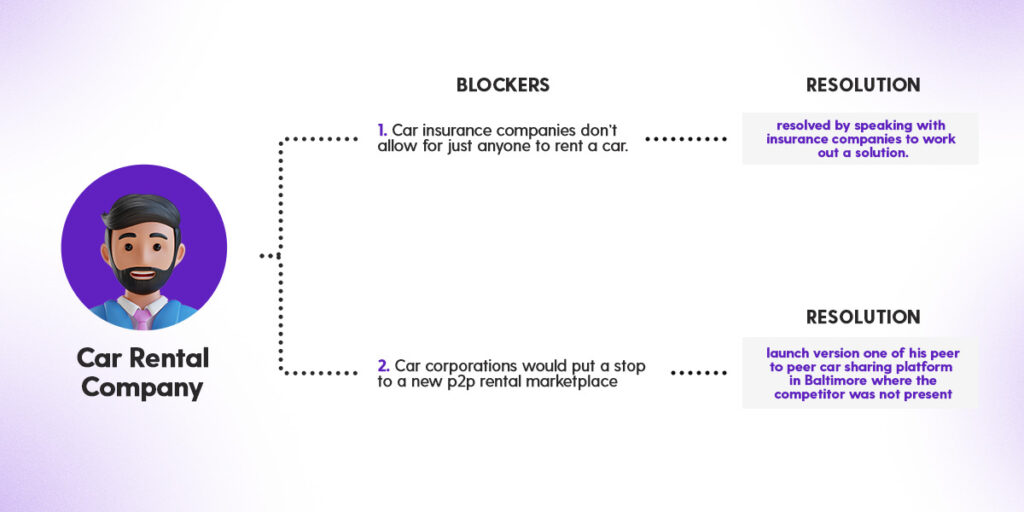
The first blocker would be resolvable by speaking with insurance companies to work out a solution. The second blocker concerned Shelby more as he was worried that the large car companies would put a stop to a new p2p rental marketplace for cars just as the big music labels had pressured p2p music sharing platforms like Napstar to shut down in 2001.
To overcome the second blocker, Shelby decided to launch version one of his peer to peer car sharing platform in Baltimore. After a quick search he found that Baltimore has some of the worst customer demographics for car sharing such as high rates of crime, low population density, high car ownership rates and so on. However, Baltimore had one thing that cities like Boston did not have – ZipCar did not exist in Boston.
With these two solutions in mind, Shelby began to map out how Turo would work, considering first at a high level how a p2p car rental marketplace could work.
How to build a car rental website like Turo?
Turo built its business through an iterative process whereby the company made frequent updates to their technology and marketing.
Each adjustment made was as a deliberate and targeted response to particular challenges that their customers faced in using their product.
There were six main steps that the company took to get to new stages of their business life. These are listed below:
Idea stage: finding a problem to solve
All good businesses start by finding real problems to solve for a target audience.
Amazon identified the need for convenient online shopping and streamlined delivery, addressing the hassle of traditional retail experiences.
Airbnb recognized the demand for unique and affordable accommodation options, providing travellers with personalized and immersive experiences beyond traditional hotels.
In Turo’s case, they realized that in the United States there are 20% more cars than drivers. This means that there are millions of under utilized vehicles in the United States.
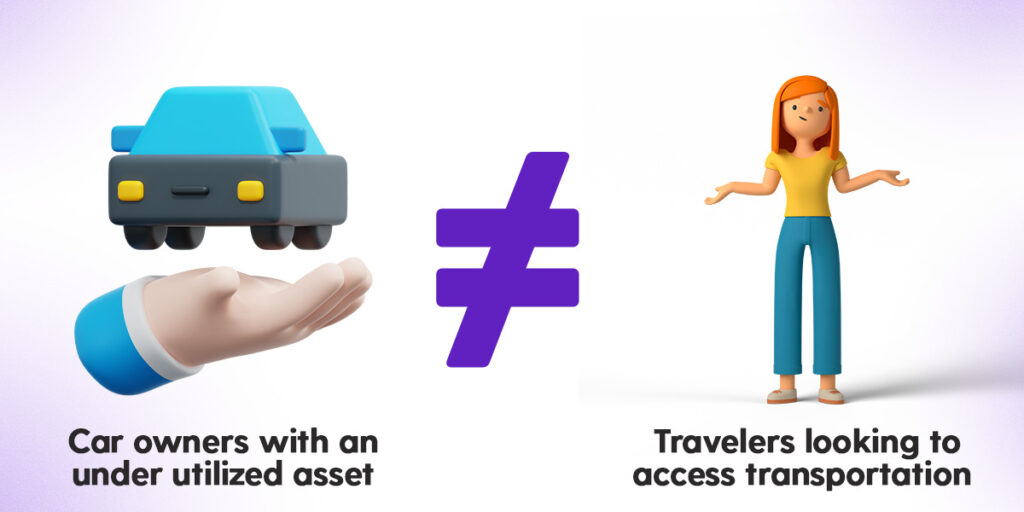
When a vehicle is not being used fully, this leads to unnecessary costs for the car owner such as vehicle upkeep, depreciating value, insurance and so on.
Turo’s platform solves these problems by utilizing the peer to peer marketplace model. In this model they connect car owners with travellers looking to access transportation. Travellers can visit Turo’s website or mobile app, browse through lists of cars and then rent out the cars for a short period of time.
1. Access trumps ownership i.e. I care more about getting from point A to point B than owning a car.
2. Value unused is waste.
Of course, travellers could also look on alternative platforms such as Facebook Marketplace to find and rent cars; however, Turo offers more than just a list of cars. The platform also gives travellers:
- A wide variety of cars at a range of prices
- A simple renting experience where travellers can easily search from a list of vehicles, agree on a price, period and mileage and then pick up the vehicle.
Meanwhile, Turo offer car owners:
- An active market of travellers who want to rent out their cars
- Flexible scheduling options to set availability according to their preferences
- Insurance coverage for both owners and renters of up to $750,000, ensuring peace of mind during rentals
- Detailed profiles and reviews to showcase their vehicles and build trust with potential renters
- Access to a large and diverse pool of renters, maximizing the potential for bookings
- Support and assistance from Turo’s customer service team throughout the rental process
Getting insurance
We’ve already seen how Shelby came up with the initial idea for a peer to peer car rental marketplace while living in Boston. As mentioned, the primary blocker in the early stage of marketplace development was car insurance.
Traditional insurance policies didn’t extend to cover commercial rental activities. This left both parties exposed to financial risks in case of accidents or damages during the rental period. To overcome this, Turo partnered with Liberty Mutual who created a bespoke insurance policy that resolved the issue.
Once the insurance issue had been resolved, Shelby set out to test the central hypothesis of Turo which was: “will people let strangers drive their cars”.
Idea validation: proving problem-solution fit
At the start of Turo’s life, Shelby went out and met thousands of possible investors. Each investor told him that the idea for a p2p car rental marketplace sounded like a good idea however, they did not believe that people would let strangers drive their cars.
Car sharing had already been proved by the platforms like ZipCar who had developed a model where people could rent cars from the ZipCar fleet. However, this is very different from the peer to peer car rental model where strangers rent cars from strangers. As such, Shelby realized that he needed to prove, unequivocally, that people would allow them to build a marketplace. As such, he launched a really basic website that cost him $2000. This website presented a really high level view of peer to peer car sharing and offered users a place to sign up their cars.
The next step is to get people to sign up to his website. With peer to peer marketplaces this represents a challenge since without car owners, there is no reason for renters to come to the site. Meanwhile, without renters, there is no reason for car owners to sign up. This is known as the marketplace chicken and egg problem and there are many strategies used to solve this.
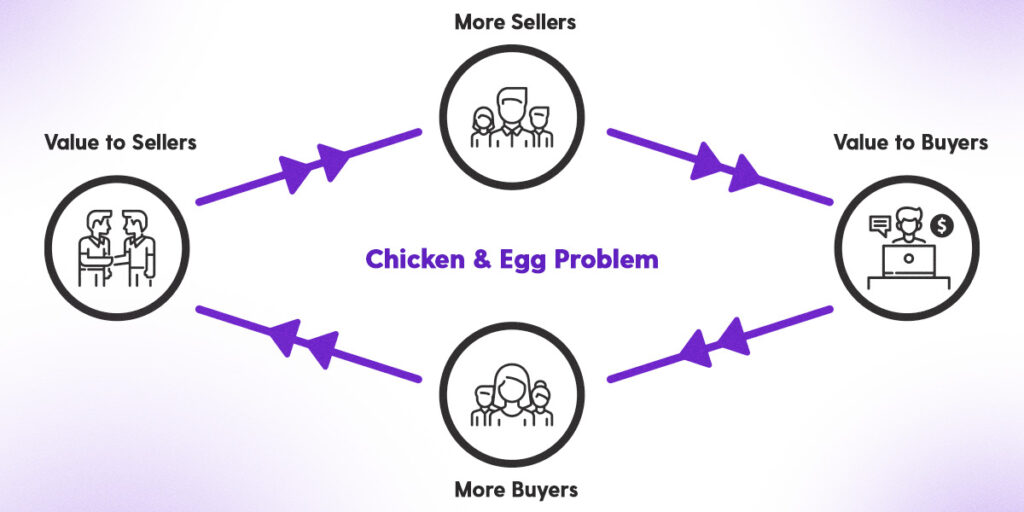
In Shelby’s case, he solved the chicken and egg problem by printing out 10,000 postcards showcasing the concept of Turo and went out into the street to start having hundreds of thousands of conversations with people where he tried to convince people to sign up their car to his website. Shelby explains that the results from these initial discussions were very polarizing, some people were not willing to let strangers rent out his car and then other people saw the benefit of getting paid while someone else drove their car.
At the end of the initial session, Shelby had 40 strangers who had signed up to this car sharing application. However, at this point it did not mean anything, since there was no actual way for people to actually rent out their car. All that being said, Shelby had proved the initial concept and was ready to return to investors with his statistics to prove that there was a demand for his idea.
To build a basic prototype to test out a new concept for peer to peer car rentals, check out Dittofi’s peer to peer car rental marketplace template. This solution includes all of the essential features that you need to onboard new car owners and renters. Using this solution you can immediately take to the streets and start getting users to upload their cars onto your platform. A screenshot of the marketplace template is shown below.
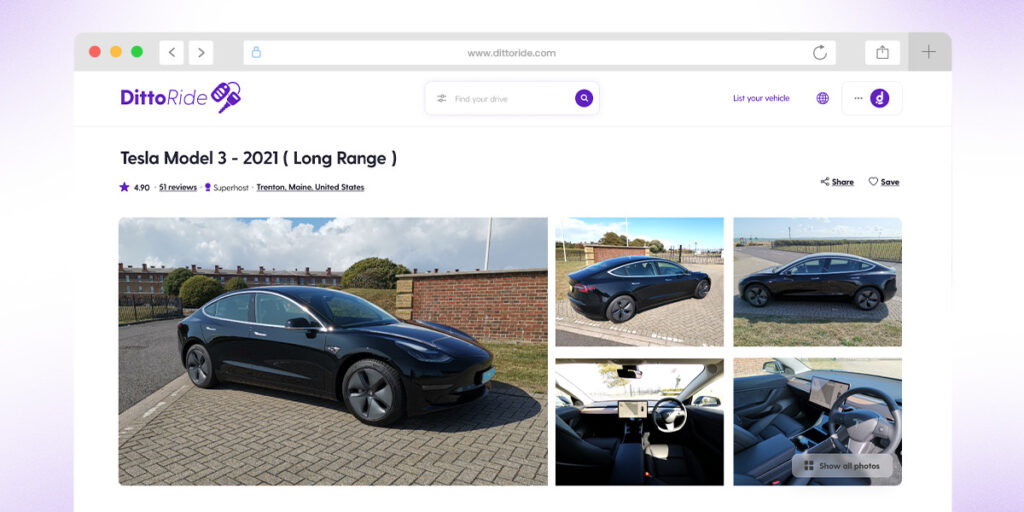
Choosing a business model
After Shelby had proved that people are infact willing to rent out their cars to strangers, he then constructed Turo’s business model.
There are several marketplace business models that car rental marketplaces can use. In Turo’s case, Shelby chose the commission model. This means that since Turo does not own any inventory on its marketplace, the solution makes money by facilitating transactions on their website. When a transaction takes place, Turo charges car owners a transaction fee based on the rental price of their vehicles.
For example, let’s suppose that you list your car on Turo’s car rental website for $100 per day and someone rents out your car for 5 days at $500. Turo will charge you a commission (or take rate) of say $100 (20% of the price of the ride) for giving you the option to list your car.
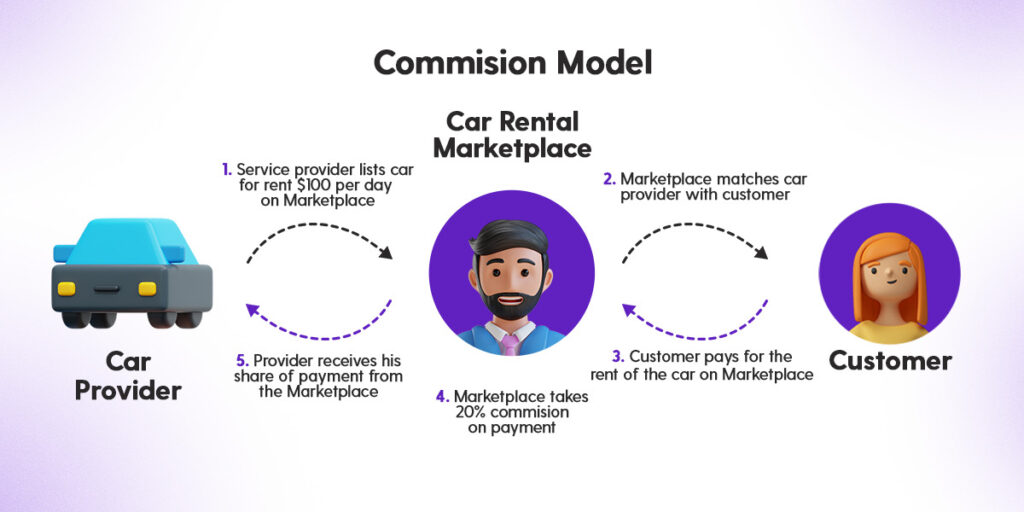
At a high level this is how Turo’s business model works however, the pricing model has evolved over time. They now have a more dynamic pricing model where they charge a variable commission that ranges from 15% – 45% based on various factors such as vehicle type, duration of the rental, demand, location, and additional services. All that being said, the average commission is usually no more than 25%.
Understanding how Turo makes money is only one tiny fraction of their overall business model. To really understand how Turo’s business model works, we need to dive deep into Turo’s target market and how they evolved their business strategy over time.
A city by city approach: building a service
Armed with the data, Turo was able to raise their first round of capital and build out their marketplace idea.
Once they had the first version of their system also called a marketplace MVP, they set out to take a city by city approach where they attempted to replicate the ZipCar model of car sharing, but instead apply it to a peer to peer marketplace model.
This led to the first iteration of their product which was really Turo as a peer to peer ZipCar replacement. The solution offered car owners and renters a really high touch service and was focused on hourly rentals that were hardware enabled.
In practical terms this meant that Turo targeted people who needed a car to run a short errand, say anywhere from 15 minutes to three hours. Turo would then install physical hardware into the cars that allowed the Turo team and car owners to track the whereabouts of the car, giving drivers a sense of security.
Finally, being a ZipCar replacement, Turo offered more of a three step, service based, booking model where renters would:
- First request a quote from several car owners.
- Second, Turo would communicate these quotes to car owners who would send quotes back to Turo.
- Finally, Turo would quote these rates to the renter and the renter would then choose the car owner that they wanted to use.
There were several issues with this model.
- Cost of insurance. The cost of insuring someone for 15 minutes to an hour was as high as insuring someone for an entire day. Therefore, people were paying for insurance that they didn’t need and this led to some pretty disastrous unit economics.
- The high touch, service style based booking model was fraught with inefficiencies. For Turo to onboard a car, they needed to install physical hardware into the car. Second, the booking model made it really difficult for people to book cars quickly.
- Hosts struggled with short booking times for their vehicles. For example, with just one 15 minute booking, a host needed to wash their cars, fuel them and deal with the mileage.
Unable to easily agree on solutions to these problems, Turo’s board and investors felt like it was time for a change in leadership.
A nationwide approach: finding product-market fit
After a difficult start for Turo, the company brought in a new CEO called Andre Haddad in 2011. Andre changed the Turo business model entirely. Instead of focusing on building a peer to peer car rental marketplace as a replacement for ZipCar, he changed the turo business model to a car sharing marketplace like Airbnb.
In practical terms, this meant moving to a low touch marketplace business model that focused on day or weekly rentals that used a “key exchange” model.
The result was:
- Offering longer term car rentals to overcome the issues with 15 minute to 3 hour rentals. This resolved the problems of poor unit economics around the insurance for car owners and renters and car owners needing to continually clean their cars.
- Removed the friction of needing hardware to be installed, allowing for the development of a marketplace network effect.
Within 2 months of introducing a weekly price for car rentals, the weekly rate became one third of Turo’s total revenue. This demonstrated to the marketplace operators that what people wanted was a p2p car rental marketplace much more like Airbnb, where travellers could rent out something for a longer period of time.
Following the success of this model, Turo decided to introduce a monthly rate. This immediately became 20% of their revenue. Each of these changes allowed Turo to really understand what they were as a company and ultimately allowed them to find deep product-market fit and start to scale. In 2023 Turo did $879.8 million in revenue and is now profitable.
Although this ended up being a successful shift in direction for Turo, it almost was not. The changes required to the platform required the engineering team to completely rebuild the solution. This took months and led to huge friction within the team. Ultimately staff were not happy with the huge uptick in work required to modify the platform and the company was running out of money.
Nowadays hybrid no-code solutions like Dittofi can help you find product-market fit faster by enabling you to make rapid iterations to your rental marketplace solution without coding, with complete flexibility and by using auto code generation to transform your no-code designs into a an enterprise grade marketplace technology stack (React and Google Go). Learn more about how to build a rental marketplace with Dittofi, fast.
Conclusion: How to build a car rental website like Turo
Shelby Clark tells founders who are thinking about building a rental marketplace like Turo’s, don’t be afraid of failure. Failure is just part of doing business. Whilst Turo was a massive success, Shelby references his subsequent business Peers which failed to get off the ground.
The second thing he points out is that peer to peer rental marketplaces are the future. Shelby points out that businesses set up in this space are perfectly primed to take advantage of the sharing economy, which is driving changes in consumer behaviour.
If you’re thinking about building a peer to peer car rental marketplace like Turo, check out Dittofi’s p2p rental marketplace templates. These solutions can help you quickly test and validate a marketplace idea, rapidly iterate your business model based on customer feedback and then ultimately scale up.
Although starting a marketplace business might seem daunting, don’t be afraid of failure, stick to the iterative process and work hard to make your marketplace take off.
Book a call with one of our marketplace specialists to learn more about how to build a peer to peer car rental marketplace like Turo with Dittofi or sign up to our 14 day free trial and build your marketplace today.
Become a Marketplace Insider
Join our inner circle for exclusive insights, coveted trade secrets, and unparalleled strategies – your journey to marketplace dominance begins here.
